Please be patient, this web page takes a moment to load.
Protein
Propaganda:
Deciphering Fact from
Fiction

Today's
supplement market abounds with propaganda and misinformation purposely
generated to confuse consumers so that companies marketing proteins and
other nutritional items can drastically increase their overall profitability.
Technical jargon is commonly used to cloud consumer perception of what
a product should cost and to make commonplace ingredients seem larger
than life. Why? Quite simply, because unscrupulous companies (most of
which don't even manufacture their own products) know the more spectacular
they can make a product sound, the more they can sell - which equates
to more money in their pockets. So called, "advanced delivery systems",
ridiculous claims of Biological Values (BV) well in excess of 100, misleading
"before-and-after" pictures, and far reaching references to the scientific
literature are just a few examples of the tactics that companies are currently
using to sell protein supplements. Judging from the fact that some
companies continue to propagate them, it's apparent that they have realized
huge profits from these devices; but at what cost? These shady marketing
campaigns have tarnished consumer perspective about protein supplements,
and more specifically - the type of protein(s) being used to produce these
supplements.
Not
Anti-Protein... Just Anti-Hype!
There's no doubt
about it, consuming adequate amounts of high-quality protein is essential
for continual gains in strength, tone and size. This is especially true
for athletes since active people certainly require more protein than
sedentary individuals (i.e. your average couch potato). But some companies
would have you believe that their products can do anything. Don't be
fooled by the hype! Let's face it; protein serves many functions in
the body but a protein supplement isn't going to turn you into the next Mr.
or Ms. Olympia, especially if you don't eat right, train hard, reduce
stress and get enough rest each night.
Protein,
in a Nutshell
Athletes,
particularly strength-training athletes, love protein. Many are fixated
on how much protein they consume, what sources they use, which foods
/ supplements they combine protein with, even what time of day they
take it. No surprises here. But what may surprise you is the number
of athletes who buy, use and reorder these items without even understanding
what they do or why they use them. In fact, we answer more questions
(e.g. What is it? What it is used for? Why do I need protein?) about
protein than just about any of the over 400 other products that we manufacture.
This cursory overview is intended to address many of these topics and
was included to provide a basic understanding about the importance of
proteins and amino acids.
Proteins are distinct
from other macronutrients (carbohydrates, fats and alcohol) in that
they are comprised of chains of nitrogen-containing subunits called
amino acids. All amino acids are important due to the fact that they
are the primary source of dietary nitrogen (an essential element). However,
some can be synthesized in the body from other materials and for this
reason are not considered essential. Of the 22 amino acids commonly
found in nature, eight (please refer to TABLE 1) are essential because
the body is unable to manufacture them at any point throughout the lifecycle.
These amino acids, aptly named essential amino acids (EAAs) must be
obtained in appreciable amounts and on a consistent basis from exogenous
sources (foods or dietary supplements) to prevent deficiency. Seven
other amino acids are considered conditionally essential (CEAAs) because
the body may have difficulty synthesizing them, or enough of them, under
certain conditions such as illness, surgery, extreme emotional stress
and intense physical activity. The remaining amino acids can be produced
as needed, provided the body has access to all the necessary raw materials
(nitrogen, carbon, sulfur, etc.), and are therefore classified as nonessential
amino acids (NAAs). Using the three groups of amino acids mentioned
above, the body polymerizes (links) elaborate chain-like molecules called
proteins. Among other things, proteins function: (1) to maintain body
structure (e.g. collagen, keratin, elastin); (2) in transport (e.g.
hemoglobin, albumin); (3) to facilitate movement (e.g. actin, myosin);
(4) in metabolism (e.g. numerous enzymes); (5) in immune function (e.g.
immunoglobulins); (6) in regulation (e.g. various hormones, neurotransmitters).
More importantly, at least to many page 3 bodybuilders and athletes,
amino acids are the "building-blocks" of lean muscle tissue.
Table1
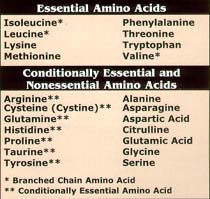
The body's ability
to synthesize these and thousands of other proteins is dependant upon
the availability of all the amino acids at any given time. Unlike carbohydrate
and fat, which are stored as glycogen and triglycerides, respectively,
the body only maintains a very small pool of amino acids. If one or
more of the EAAs in this pool is low, the body is unable to complete
synthesis of any of the proteins calling for this/these amino acids.
Scientists often compare amino acids to letters in the alphabet and
intact proteins to words to help people better understand the importance
of having all the amino acids present when protein synthesis takes place.
Using this analogy, one could easily imagine how difficult it would be to construct
words and sentences without letters. Disturbingly, even short-term EAA
or CEAA deficiencies can stifle the important repair and rebuilding
process associated with all healthy cells, especially growing muscle
cells. Luckily, this scenario can be easily prevented with a well balanced
diet containing adequate amounts of high-quality protein. Current research
indicates that one half to one gram of quality protein per pound of
body weight (0.5 - 1.0 g protein / lb of body weight) is sufficient
for most any athlete. This is especially true if your overall caloric
intake is great enough to prevent the utilization of amino acids for
fuel.
Protein
from Foods vs. Supplements
It is possible
to get all the nutrients you need from foods, if you plan and prepare
your meals carefully. At minimum, daily meal planning involves a considerable
amount of time, shopping savvy and recipes. To complicate matters, it
can be very difficult to find foods/recipes that contain every thing
you want without all of the things you'd rather not have. For instance,
foods that are rich in protein (e.g. beef, whole eggs, pork) also tend
to contain appreciable amounts of fat, saturated fat, cholesterol and
unwanted calories. What's more, these foods often require refrigeration
and careful handling to minimize exposure to potentially harmful microbes.
Last, but not least, these foodstuffs commonly require cooking, which,
in turn, necessitates time, cleaning, kitchen space and utensils and
some rudimentary cooking skills.
In contrast, protein
and meal replacement supplements generally require little more than
a glass, some water or your favorite beverage and a spoon to prepare.
These dietary aids require no refrigeration until they are mixed and
they are portable enough to be carried in a gym bag or purse. Furthermore,
protein supplements are often more cost effective than many protein
rich foods and allow for better calorie / macronutrient control. Protein
/ Meal Replacement supplements are also a means through which individuals
with limited appetites can increase their daily protein / caloric intake
without consuming inordinate volumes of food. Regardless of which combination
you end up using, a good quality protein will provide high levels of
the amino acid categories (see Protein in a Nutshell), especially EAAs.
Eggs, dairy products, meats, fish and poultry are among the best food
sources, while whey, egg albumen, casein and soy protein are great supplement
choices.
Considering
A Supplement?
To say that
there are several protein supplements commercially available to athletes
would be a gross understatement. The average health food store or gym
carries scores of products, many of which are protein based. There are
whey proteins, milk proteins (casein rich), egg proteins, soy proteins,
etc. How is a consumer to decide? Many factors should be considered
when choosing a protein supplement. These include: organoleptic traits
(e.g. taste, texture, aroma), price, protein content per serving, and
quality. Traits such as taste, texture and aroma are important because
it is almost impossible to regularly consume a product (which is suggested
for best results) if it is a terribly unpleasant experience. Price in
relation to protein content is also significant to consider as a method
to ensure that a "good price" is not an indication of low protein content
or that a premium price isn't simply a fee for a "brand name". Though
all of these factors are worthy of attention, primary consideration
should be paid to protein quality when choosing a supplement.
Evaluating
Protein Quality
There are several ways to evaluate protein quality. It is important
to realize that protein quality is not simply a subjective physical
attribute, rather it is a biochemical/ physiological characteristic
that is evaluated based upon a protein's amino acid pattern, digestibility,
assimilation, and utilization traits. After all, consuming protein is
not beneficial if the body cannot digest, absorb and use it. Biological
Value (BV), Protein Efficiency Ratio (PER) and Protein Digestibility
Corrected Amino Acid Score (PDCAA's) are some of the more common
indices typically cited in textbooks, advertisements and industry-related
periodicals. While these measures can be useful for comparing one protein
to another, each of them is inherently laden with
procedural variations and potential interpretative errors and should not be used
as the sole basis for promotional claims. As an example, Biological Value (BV),
argualbly the most frequently employed method for evaluating the quality of a
protein, estimates the percentage of absorbed nitrogen (N) that is retained by
an organism. Put another way: BV = (retained N ÷ absorbed N) x 100. If
you stop to think about this calculation for a moment you will probably realize
that it is impossible for the body to retain more nitrogen than it absorbs, yet
this is the scenario that would be required to end up with a BV of > 100. So
how is it that some companies claim BVs in excess of 130? Good question. There
are many possible explanations of how these figures were obtained; experimental
errors/variations including: incorrectly calibrated equipment, methodological
variations, inaccurate calculations and faulty study design are a few. Data falsification,
marketing liberties (104,130,159...whatever it takes) and/or ignorance on the
part of the copywriter are other less comforting explanations for this trend.
In any case, the scientific community does not acknowledge biological values over
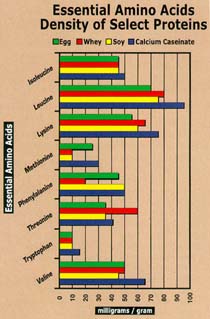
100;
neither should you. It is important to keep in mind that while most, if not all,
of the methods used for evaluating protein quality are less than ideal, these
measures do offer a general indication of how "usable" a protein is
by the body. As a rule, most of the egg, whey, soy and casein commonly found in
protein supplements from reputable manufacturers all rate very well in one or
more of these protein scoring methods.
So
What'll Be? Whey? Casein? Egg? Soy? Or all of the Above
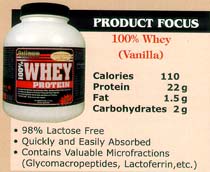
Whey
Protein Concentrate (WPC): Once discarded as "waste", the popularity
of whey has increased dramatically in recent times because of advances in processing
technology. Whey begins as a watery byproduct of cheese manufacturing. In its
crude state, whey is about 93% water, 6.5% lactose, 0.9% protein and 0.2% vitamins,
minerals, and fat-soluble nutrients. In this form, whey is not of much benefit
to athletes, but with gentle low-temperature processing and filtration, this liquid
can be stripped of most of its lactose, fat, cholesterol and water to yield concentrated
whey powders containing anywhere from 34 to 89% protein. It is important to note
that there are significant price and nutrtional value differences between the
various WPCS on the market. A WPC containing 34% protein may cost up to 80% less
than better quality whey protein concentrates with protein contents of 77% or
higher. Most protein powders use a blend of different whey protein concentrates,
isolates and hydrolysates, making it possible to hide inferior/cheaper proteins
in a product. But there's an easy way to find out... To determine the overall
protein percentage of your supplement, whey
or otherwise, simply divide the protein found in each serving by the
serving size and multiply by 100. Here is an example to help you figure
out how much of your current protein powder is actually protein: 22
g of protein per serving ÷ 28.4 g serving size x 100 = 77.5% protein.
Keep in mind; it is impossible to end up with a product that is 100%
protein. Flavors, colors, sweeteners, micronutrients, etc. that are
used to make these supplements more completely nutritious and enjoyable
to consume, necessarily displace some of the space that could be occupied
by protein. Nevertheless, it's important to account for these fillers,
since grams of protein per bottle is what most consumers are really
after.
Table2

Whey Protein
Isolates (WPIs):
Crude, or sweet dairy whey, can also be "isolated" via cross flow microfiltration
(CFM) or ion exchange (IE) processes to produce whey powders that are
virtually fat, carbohydrate (lactose) and cholesterol free. By definition
WPIs contain >90% protein by dry weight. There are a few premium supplements
that derive all of their protein content from WPIs (one of these is
Iso-Whey by Optimum Nutrition), but WPIs are most often used in conjunction
with Whey Protein Concentrate (WPC) and /or other proteins to boost
the overall protein content of a supplement.
Many people often
ask which isolation process is better. The following paragraphs give
a brief overview of the processes and the potential benefits each has
to offer.
Cross Flow Microfiltration (CFM) is a solvent-free process that uses natural ceramic filters
to separate whey proteins from a variety of undesirables (i.e. fat,
cholesterol, lactose, etc.). Advantages to this process include minimal
protein denaturation, preserved protein microfractions and a better
mineral profile. Whey, like many other proteins, including egg, soy
and casein, is actually a family of different smaller proteins called
microfractions. Glycomacropeptides, alpha-Lactalbumin, Lactoferrin,
Lactoperoxidase, and Immunoglobulins are some examples that you may
have read about in magazines or seen on labels. Because there is some
indication that these protein fractions may play a role in appetite
regulation, immune functioning, neutralizing free radicals and more,
many people prefer CFM since it is better at preserving some of these
fractions than Ion-Exchange. CFM is also generally higher in calcium
and lower in sodium than IE as a result of differences in processing
methods.
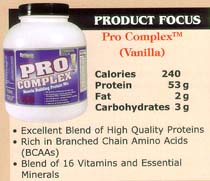
Ion-Exchange
(IE) is a process that separates proteins on the basis of their
electrical charge. Unlike CFM, ion-exchange requires the use of various
solvents to create an attractive charge on the proteins. Once charged,
these proteins migrate toward oppositely charged resin beads in the
reaction vessel. The protein can be later removed from the resin beads
by reversing the charge to result in a highly purified WPI. Ion-exchange
WPIs are not typically considered as "native" (maintaining the same
microfraction ratios found in milk) as CFM isolates, but they are richer
in total protein - containing upwards of 97% by dry weight - and are,
therefore, a popular choice among bodybuilders and athletes.
Hydrolyzed Whey
Peptides (HWP): debatably the best - at least in terms of bioavailability
- whey proteins that money can buy. HWPs are short chains of amino acids
(e.g. di-, tri-, poly-peptides) produced by strategically digesting
(with enzymes) various bonds in whole whey proteins. Preliminary research
suggests that HWPs are more easily absorbed (and probably utilized)
than any other protein that we know of. Unfortunately, HWPs have an
extremely bitter taste, so they can only be used in conjunction with
other proteins and added in relatively small amounts.
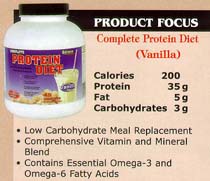
Casein: commonly
referred to as the "other" milk protein, casein actually comprises over
80% of the total protein in milk. Though not currently "en vogue"
with athletes (due, in large part, to the success of whey proteins),
casein is easily assimilated by the body and rich in all of the EAAs
(see EAA Density graph). Casein is the protein of choice in the pharmaceutical
and food industries where it is used in baby formulas, enteral nutrition
products, cheeses and numerous other applications. Many meal replacement
products also take advantage of casein's thickening properties to improve
overall taste and mouth-feel. As an added benefit, casein is digested
more slowly than whey, egg or soy to provide a constant stream of amino
acids to hungry muscle tissue. In other words, casein may offer anti-catabolic
properties. So, contrary to what you may have heard, casein is an expensive
(even more so than most whey proteins), high-quality protein and deserves
to occupy a place in every athlete's diet.
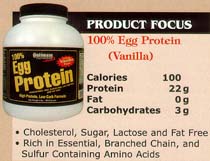
Egg Albumen:
also known as egg white, is a complete protein and an excellent source
of sulfur containing amino acids. Once the staple of bodybuilders everywhere,
egg protein has recently taken a "back seat" to whey. Although we're
not going to suggest that egg albumen is superior to whey, nutritionists
generally refer to egg as the "gold standard", or protein to which all
others should be compared. Obviously, some would argue that this opinion
is dated, in light of what we know about whey, but there's no denying
that egg proteins do offer certain advantages. For starters, egg white
proteins are lactose-, fat-, and cholesterol-free. Egg proteins also
contain high levels of sulfur, essential, and branched chain amino acids.
Finally, egg albumen contains niacin, riboflavin, magnesium, potassium,
chloride and other nutrients that athletes need, so don't forget about
this great product the next time you're in the market for a protein
supplement.
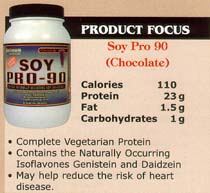
Soy Protein: is
unique in that it is a complete, meaning it contains all of the EAAs
in adequate amounts, vegetarian protein. Though soy has been a staple
of the Asian diet for thousands of years, this vegetable-based protein
has just started to gain recognition in the U.S. Much of this newfound
popularity can be attributed to three factors: (1) Recent advances in
soybean processing techniques. (2) The identification and isolation
of health promoting compounds called isoflavones. (3) The recent approval
of a "heart-healthy" claim by the FDA.
Thanks to new processing
techniques, the quality of the soy protein-based supplements that are
currently available are much higher than those previously marketed.
These techniques enable manufacturers to selectively remove non-protein
components (fibers, oils, minerals, etc.) and better isolate two key
components in soy: protein and isoflavones. Soy Isoflavones are naturally
occurring compounds that appear to act as antioxidants and natural hormone
modulators in the body. At least two, genistein and daidzein, isoflavones
are believed to be biologically active in a variety of capacities in
the human body. Though the reasons "why" are not yet well
understood, research comparing Asian Versus Western diets suggests that
something in soy may play a significant inhibitory role in certain cancers,
osteoporosis and atherosclerosis development. The body of research done
on soy and cardiovascular health is so strong that the Food and Drug
Administration (FDA) has recently approved a Health Claim stating that
diets low in saturated fat and cholesterol that include 25 grams of
soy protein a day may reduce the risk of heart disease. Keep in mind;
this is monumental seeing as how there are less than ten allowable Health
Claims for all foods! If you still need more reasons to convince you
to try soy, consider the following: Products containing soy protein
isolates typically yield more protein per serving than whey, egg or
casein (please refer to TABLE 2). Soy is naturally free of cholesterol.
Soy is non-animal based and is, unless mixed with other animal products,
suitable for vegetarians.
Putting
it all Together
If we accomplished our objectives, you are beginning to question much
of what you have seen and read about proteins up until now. Although
much of the bio-speak that spews from the bodybuilding media is questionable,
you can pretty well bank on these eight points: (1) proteins have different
amino acid patterns/ratios; (2) some proteins are more digestible than
others; (3) proteins are absorbed at different rates; (4) blends containing
multiple proteins may be more advantageous than proteins derived from
a single source; (5) whey, egg, casein and soy are all very high quality
proteins with different taste and functional characteristics; (6) athletes
require more protein than sedentary individuals; (7) a
high quality protein will be easily digested absorbed and utilized by
the body; (8) every year will bring new hype and new supplement companies
out of the woodwork. Do yourself, and your pocketbook, a favor...QUESTION
WHAT YOU READ AND HEAR AND LEARN AS MUCH ABOUT PROTEIN SUPPLEMENTS AS
YOU CAN.
Information provided by Optimum
Nutrition